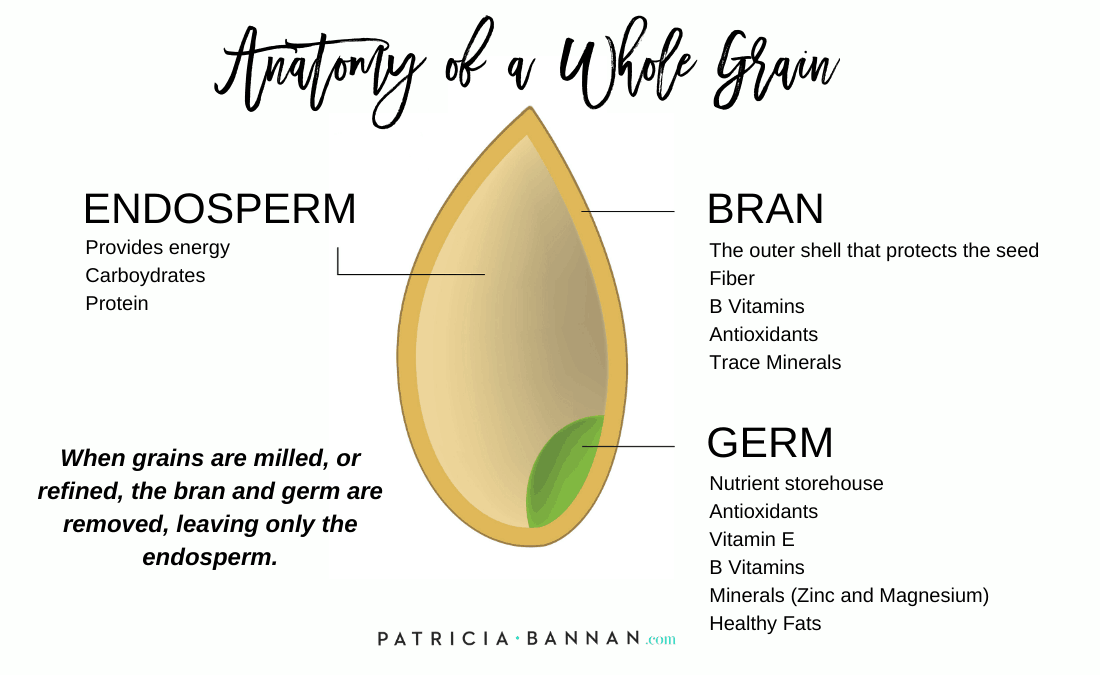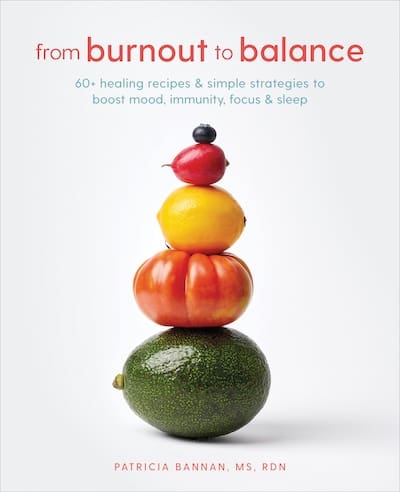Whole grains are nutrient powerhouses with a range of health benefits. Here’s what you need to know, with a list of whole-grain options and recipe ideas.
Sure, we know we’re supposed to eat whole grains. But for some people, it may be more difficult than making a sandwich on wheat bread. While Americans eat plenty of grains, the typical American consumes less than one serving a day of whole grains – and whole grains provide a wealth of nutrients their refined versions lack. Let’s take a closer look at what whole grains are, their benefits, how much we need, and tasty ways to eat them.
What are Whole Grains?
Whole grains are the seeds, or kernels, of plants that grow in the ground. They are made up of three different parts, each which contains valuable nutrients for good health and daily energy.
Parts of a Whole Grain
The anatomy of a whole grain has three parts — the bran, germ, and endosperm — all still present in the same proportions as when the grain was growing in the fields.
The bran is the multi-layered outer skin of the edible kernel. It contains fiber, B vitamins, and important antioxidants. The germ is the embryo which has the potential to sprout into a new plant. It contains many B vitamins, minerals, some protein, and healthy fats. The endosperm is the germ’s food supply and is by far the largest portion of the kernel. It contains starchy carbohydrates, proteins and small amounts of vitamins and minerals.

Benefits of Whole Grains
Research suggests a diet high in whole grains may help reduce your risk of heart disease, cancer, stroke, obesity, and other diseases. Whole grains may also help reduce inflammation in the body. Replacing refined grains with whole grains has the potential to improve the gut microbiome. While the fiber content contributes to these benefits, the other nutrients are just as important. Whole grains are packed with vitamins, minerals, phytonutrients (powerful plant-based compounds), and healthy fats.
Interested in learning more about fiber? Stay tuned for another article coming soon.
Whole Grain vs. Refined Grain
While all grains provide complex carbohydrates, vitamins, and minerals, whole grains offer more bang for your buck. The reason? Eating the entire grain means you get all the nutrients and all of the fiber in the seed. When a grain is refined or processed, the endosperm and bran are removed. That means refined grains have fewer vitamins and minerals, and less fiber than whole grains. Plus, getting rid of the outer shell, the bran, also means getting rid of the important phytochemicals that give grains their special color.
Examples of Whole Grains
Oats and whole wheat are just a few of the many types of whole grains! Check out the list below for new ideas. If you have Celiac disease, a wheat allergy, or a gluten sensitivity, there are still a multitude of gluten-free whole grains to choose from. Each grain with an asterisk (*) indicates that it’s gluten-free.
- Amaranth*
- Barley
- Buckwheat*
- Bulgar
- Corn*
- Einkorn
- Farro/ Emmer
- Freekah
- Kamut
- Millet*
- Oats* (can be gluten-free – look for those labeled gluten-free to eliminate the chance of cross contact with gluten)
- Quinoa*
- Rice*
- Rye
- Sorghum
- Spelt
- Teff*
- Triticale
- Wheat
- Wild Rice*
Grab yourself some whole-grain corn tortillas and you can make these Ultimate Street Fish Tacos.
Whole Grain vs. Multi-Grain
Opting for whole-grain versions over their refined cousins is a simple way to improve your nutrient intake. But that’s not always as simple as it sounds. Take the word “multi-grain.” Sounds good, right? Well, it may mean that the product contains more than one grain but not necessarily whole grains. To be sure, check to see that the word “whole” is the first word listed in the ingredients, like whole wheat. In addition, many products contain a golden Whole Grains Stamp, which can help you figure out how much of the grains are whole.
How Much Do You Need Daily?
Here are the MyPlate guidelines based on age and gender for how many servings of grains to eat per day. Aim to make at least half of these servings whole grains. For reference, one ounce-equivalent is equal to about ½ cup of cooked grains, 1 cup of cereal, or 1 slice of bread.
| Gender | Age (years) | Daily Grain Serving Recommendation (ounce-equivalents) |
| Female | 19-30 | 6 |
| 31-50 | 6 | |
| 51+ | 5 | |
| Male | 19-30 | 8 |
| 31-50 | 7 | |
| 51+ | 6 |
Meal Ideas with Whole Grains
Cooking with whole grains and whole-grain foods shouldn’t be boring! If you or someone in your family prefers the taste of refined grains, try mixing half whole grains with half refined grains to start. For example, try using half all-purpose flour and half whole wheat flour in baked goods. The taste may be different at first, but your taste buds will adjust over time. Here are a few delicious recipes you can try to reach your daily whole grain target:
- Super Grains Salmon Burger
- Sunny Side Up Avocado Toasts
- Killer Veggie Pizza
- Orange Quinoa Salad with Pomegranate and Tangy Turmeric Dressing
- Quinoa Salad with Radicchio, Dried Cherries, and Pistachios
- Blueberry Ginger Jam-Filled Scones
What is your favorite whole grain? Comment below!






